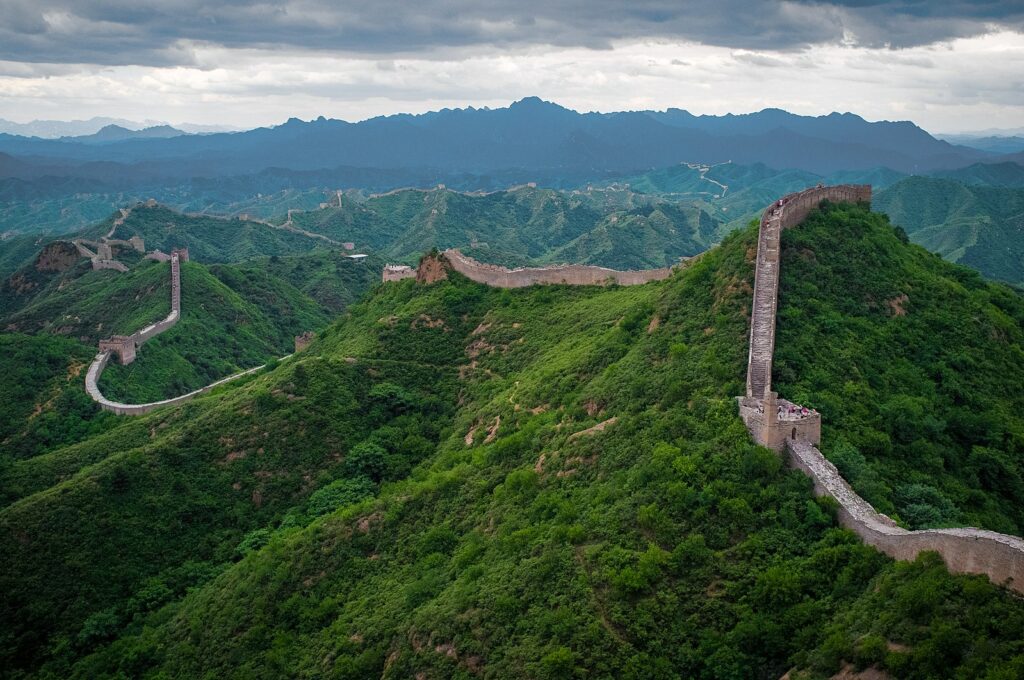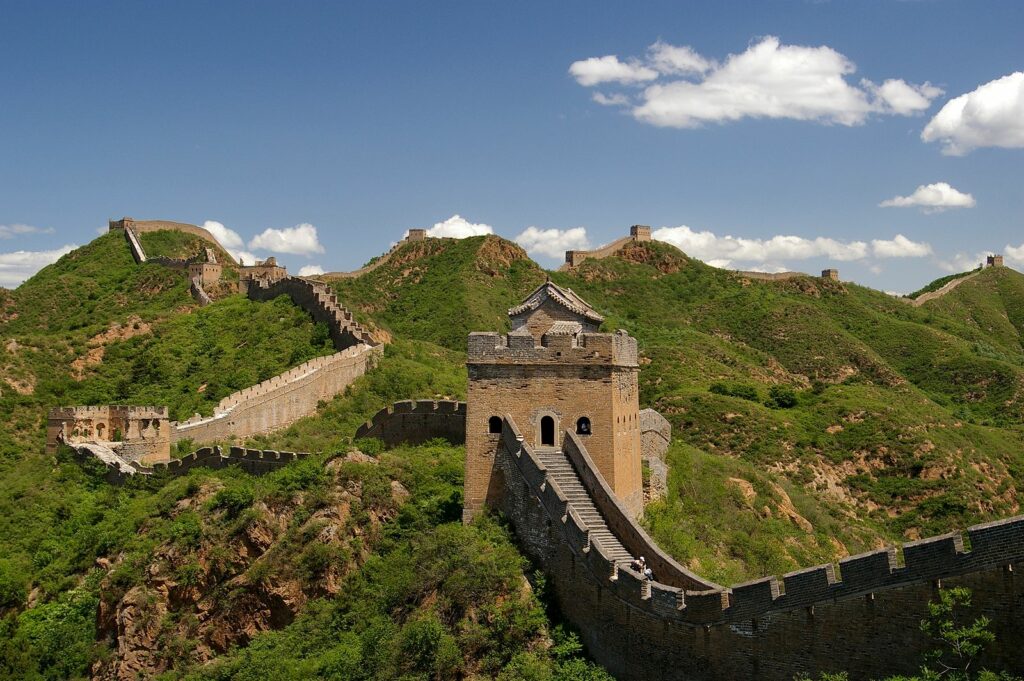The Great Wall of China was built as a protective fortress to keep enemies at bay. Today, it is one of the most visited tourist attractions in the world.
According to Travel + Leisure, around 10 million people visit the Great Wall of China every year. The majestic attraction is located in northern China in the Huairou District which is some 50 kilometers away from the Beijing city center.
The attraction’s name perfectly encapsulates the grandeur of the area, which is quite extensive at 21,196 kilometers. It is not just one wall but a series of walls, most of which run parallel to each other to form a giant protective structure. It was built over two millennia ago.
Now, let’s take a look at how it all started.

How and When the Great Wall of China Was Built
The Great Wall of China spans over 13,000 miles in length and is considered the country’s most recognizable symbol.
To ask how it was conceived is to talk about the Warring States (481/403-221 BCE). This was a period in China’s history defined by a lot of fighting among rival kingdoms and states.
The Qin Dynasty (221-206 BCE) under Qin Shi Huang successfully united the kingdoms into one Chinese Empire. Though it only lasted briefly, it gave birth to the wonder that is the Great Wall of China.
Emperor Qin had the idea of erecting an expansive fortress to prevent barbarian nomads from entering China.
There were already some fortifications on the Chinese border by the time Qin became emperor. But he ordered the removal of the structures so one great wall, spanning more than 10,000 li (according to History.com, a li is equivalent to one-third of a mile), could be built. The structure was then referred to as the Wan Li Chang Cheng, which translates to a 10,000-li-long wall.
The structure was mostly made of stone and earth. Because of the difficulty in transporting materials, Chinese workers used local stones from the mountain ranges where the structure lies. It stretched from the Shanhaiguan port of the China Sea and traversed 3,000 miles west into the Gansu Province.
The wall’s base is between 15 and 50 feet while its height is between 15 and 30 feet. Further fortifying this massive defensive structure were guard towers spread along the perimeter.
The Fall of the Qin Dynasty
Emperor Qin died from an unknown disease in 2010. He was 49. His death caused China to revert back into a warring nation which led to the fall of the Qin Dynasty just four years after Qin’s death.
He was buried in a mausoleum that became another tourist attraction in China known simply as the Qin Tomb. Also called the Mausoleum of the First Qin Emperor, the tomb is located in an archaeological site near the modern city of Xi’an. The tomb is created like a city with Qin’s tomb surrounded by a terracotta army supposedly guarding him in the afterlife.
The Han Dynasty (206 BCE to 220 CE) succeeded the Qin Dynasty. It was a great turning point for Chinese civilization but not for the Great Wall, as the country fell victim to many raids.
When the Northern Wei Dynasty (386-535 CE) came into power, massive repairs were done to the Great Wall. Some walls were also extended to defend the country from more raids.
The succeeding dynasties, Bei Qi Kingdom (550-577) and Sui Dynasty (581-618), also performed repairs and expanded the Great Wall of China.
Expansion of China Beyond the Wall
The Tang Dynasty (618-907) was another turning point in Chinese civilization that rivaled the Han Dynasty.
At this point, the Great Wall of China lost its significance as a fortified structure as the Chinese successfully expanded its territory beyond the wall after defeating the Tujue Tribe.
When Genghis Khan established the Yuan Dynasty in China, the Great Wall didn’t serve its protective purpose. But the great warrior ordered soldiers to man the structure and protect merchants traveling through the Silk Road.
Construction Boom in the Ming Dynasty
The fall of the Yuan Dynasty gave rise to the Ming Dynasty (1368-1644). The oldest structures you will find at the Great Wall of China today were from the Ming Dynasty.
Ming Dynasty leaders didn’t need the fortifications because Chinese culture flourished at the time. There were many constructions, particularly in Beijing which became the country’s capital.
The Ming Dynasty ushered in many construction projects, including bridges, pagodas, and temples. The Great Wall that you see today was first constructed in 1474.
The whole structure expanded from the Yalu River in Liaoning Province to the Taolai River in Gansu Province. It snakes through the following provinces: Tianjin, Liaoning, Hebei, Beijing, Shanxi, Inner Mongolia, Ningxia, Shaanxi, and Gansu.
The earlier construction of the wall made use of cut stones. During the Ming Dynasty, bricks were largely used for construction.
Symbol of Chinese Strength and Patriotism
While the Ming Dynasty fell and was succeeded by the Qing Dynasty (1636-1912), the Great Wall of China remained standing. It has become an important symbol in the country that represents strength. It is also a psychological representation of its patriotism and the barrier it has cultivated against foreign influences.
The majestic structure is one of the reasons foreigners travel to China. China was the fourth most-visited country in the world in 2019 with 65.7 million tourists. Other countries that topped the list were France, Spain, and the United States.
Tourists cannot walk all the way around the entire Great Wall, and instead must go to sections of the wall. There are around 10 sections that are open to tourists where one can find beacon towers, passes, and blockhouses. The sections are known as Laolongtou in Hebei, Jiayuguan Pass in Gansu, and Badaling in Beijing.
The Great Wall is often hailed as one of the best man-made wonders in the world. It is, in fact, one of the seven wonders of the world. This list also includes Chichén Itzá in Mexico, Machu Picchu in Peru, Christ the Redeemer in Brazil, the Colosseum in Rome, the Taj Mahal in India, and Petra in Jordan.
In 1987, UNESCO recognized the Great Wall of China as a World Heritage site.

What You Need to Know When Visiting the Great Wall of China
Visiting the Great Wall of China is an amazing and strenuous experience. It entails a lot of walking up and down the steps of the wall. It reportedly has a total of 30 million steps. However, not all sections are open to tourists.
The tourist experience usually includes just 5,000 steps or around three to four hours of walking. According to the China Highlights website, the following are the best sections of the Great Wall that tourists should visit:
Gubeikou
The section remains wild and unrestored. Gubeikou has witnessed a lot of battles and many of its battle scars are still visible in the area. According to historians, some 130 battles happened in the region.
Huanghuacheng
The lake in this section adds to the already beautiful views of the Great Wall. It is great for hiking and camping. There are also cruise boats that pass by the lake.
Jiankou
Jiankou is considered the most challenging and steep section of the Great Wall. It is also wild and untouched which serious hikers and history buffs will enjoy.
Jinshanling
Hiking enthusiasts will enjoy Jinshanling. Only half of the fortresses are restored in this section which makes for a wonderful cultural experience. Some would say this is the most beautiful area of the Great Wall because of the scenery and the glimpses into the past it affords visitors.
Mutianyu
Mutianyu is the most fully restored section which is also why it’s the most popular among international travelers. It is also considered child-friendly. Mutianyu has densely located watchtowers and fortresses.
Simatai
Those planning on visiting the Great Wall at dusk or later should visit the Simatai section. It is quite steep but the view more than makes up for it. It’s even better in the fall when the leaves of the trees turn red.
The Great Wall weaves through 15 provinces and areas, so there are more than 10 sections you can visit. Each section offers amazing views of China. It also provides a glimpse of the past dynasties that shaped China today.
Conclusion
China is one of the most visited countries in the world. It is known for its culture, delicious food, and affordable products. Undeniably, the Great Wall of China is among the country’s biggest attractions and one of the seven wonders. It is beautiful, majestic, and a great cultural representation of China.
It is also a place that is rich in history as it witnessed the rise and fall of dynasties. Despite all the rulers that came and went, the Great Wall of China continues to stand. Today, it is no longer a fortress that keeps enemies out. It is an attraction that draws people from different parts of the world.

